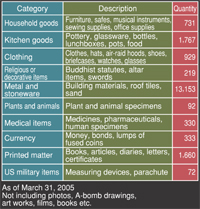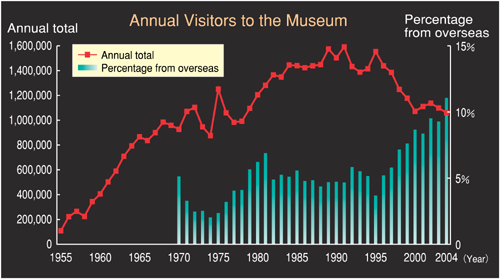 |
 |
 |
 |
47* Changes in Numbers of Museum Visitors
In 1955, the year it opened, 115,369 people toured the Peace Memorial Museum. The number of visitors has generally increased since then, the annual figure first topping one million in 1971. When the Sanyo Shinkansen train line began service in 1975, the number of school excursion groups surged. On some days more than 10,000 people toured the museum. The year the renovation of the Main Building was completed, 1991, still holds the record for annual number of visitors: 1,593,280. Since then the number of visitors has been declining, in part due to a drop in the number of school excursions.
|
 |
48* The Museum Collection
As of the end of fiscal 2004, the Peace Memorial Museum had 19,286 items in its collection. These include A-bombed artifacts and related materials, pre- and post-war materials, and many other types of items. Most of these items were donated early on by groups of private citizens. However, this cooperation from residents and the private sector has continued unabated, and we still receive numerous valuable donations. In 2004, we handled 137 donation cases that resulted in the donation of 826 items. |
 |
 |
 |
49* A-bomb Survivor Testimony
In 1979, the Peace Memorial Museum began offering opportunities to hear the A-bomb experiences of the three A-bomb survivors on staff at the museum. Beginning in 1983, we registered eight survivors as official A-bomb witnesses and began routinely offering their testimony to students on field trips and other groups. Today, though the number of museum visitors is declining, the number of schools asking to hear A-bomb testimony is increasing. The cumulative number of students who have heard this testimony at the museum since 1983 has exceeded 1.7 million.
< |
 |
50* Loans of Materials

In fiscal 2004, the Peace Memorial Museum loaned 1,036 videos, 457 sets of posters and panels, 129 sets of drawings by A-bomb survivors, and 18 sets of A-bombed artifacts. These materials were loaned to local governments, schools, and peace groups in Japan and overseas to assist A-bomb exhibitions and peace studies. |
| |
In 1970, the city of Hiroshima produced a film entitled Hiroshima: A Document of Atomic Bombing. This film had been shown regularly at the Peace Memorial Museum, and copies are loaned out in Japan. Beginning in 1976, we began loaning out Hiroshima A-bomb photos and A-bomb drawings by survivors, and have since produced other videos and posters. Today, we have many more materials, and more types of materials, available. |
 |
51* Our Website
2,184,710 hits. The number of accesses to the Hiroshima Peace Memorial Museum website in fiscal 2004. The museum's effort to make its holdings available over the Internet began in fiscal 1995 when information about the bombing was posted on the Hiroshima City website. Since that time, we have created the Hiroshima Peace Site, the Peace Database, Kids Peace Station, and Virtual Museum, and have worked continually to improve the contents. |
|





